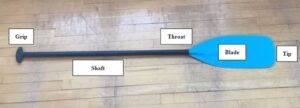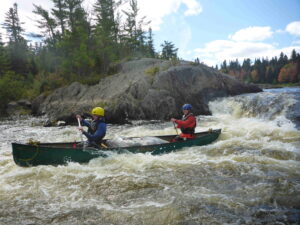Canoeing
Canoeing is a fun and versatile way to recreate outside. Whether it’s a short afternoon paddle on your local water body, a whitewater weekend, or a long canoe expedition in the backcountry, this sport can meet the needs of a wide range of abilities. For the purpose of this page, the content is designed for beginner paddlers, starting with parts of the equipment used, and basic paddling strokes.
Parts of a Canoe

Bow: This is the front-most part of a canoe. The aerodynamics of its shape allows it to cut through the water more efficiently than the stern.
Bow Seat: This is where the bow paddler or the front paddler is situated in the boat.
Stern: This is the rear-most part of a canoe, its shape helps reduce turbulence while on the water.
Stern Seat: This is where the stern paddler or the rear paddler is situated in the boat.
Gunwales: This is the edge that runs along the top edge of the perimeter of the boat. It provides surface area for other parts of the boat like the seats, yoke, and thwarts.
Hull: The bottom part of the boat that helps make contact with the water is called the hull. There are a variety of different types of hulls that accommodate for skill levels, water levels, and activities.
Keel: This is the small rounded blade that runs from the bow of the boat underneath up to the stern on the opposite end of the boat. This mechanism helps protect the hull from direct damage.
Thwart: This is the part of the boat that is placed across the width of the canoe to help support the gunwales horizontally. On tandem canoes, there are often two thwarts placed 1/3 and 2/3 of the way along the length of the boat.
Yoke: This is designed to help portage or carry your boat above your head. It has a shape cut out to fit behind your neck for comfort and is positioned in the centerline of the boat for more stability.
Parts of a Paddle

Grip: Top of the paddle, or the handle of the paddle.
Shaft: From the grip to the throat of the paddle, this is the long skinny section of the paddle.
Throat: The top of the blade or the bottom of the shaft, where the blade starts to widen.
Blade: The part that goes in the water, and is flat. Each side often has multiple purposes: the power face and the back face.
Tip: The bottom-most part of the paddle, at the end of the blade.
Basic Paddle Strokes

Forward Stroke: Moves the canoe forward. The paddle enters the water towards the bow of the canoe, with the power face pointing towards the stern of the canoe. During the propulsion phase, the paddle stays vertical to the water and the water is pushed towards the stern. This phase ends right when the paddle reaches the hips of the paddler.
Reverse Stroke: Moves the canoe backward. The blade enters the water just behind the paddler with the power face pointing towards the stern of the boat. The paddle is pushed forward, and stays vertical to the water, and is taken out a little after the paddler’s hips.
Draw Stroke: Moves the canoe sideways towards the paddle. Paddler first rotates their body so their shoulders are parallel to the side of the boat. With one hand on the grip and the other on the shaft, the paddle enters the water with the power face towards the paddle and pulls the water towards them. The paddler then moves the paddle parallel to the boat and removes it from the water.
Pry Stroke: Moves the canoe sideways from the stern. This stroke moves the canoe opposite of the draw stroke. Paddler first rotates their body so their shoulders are parallel to the side of the boat. The paddle is placed on the gunwale with the power face pointing towards the paddler. With one hand on the grip and the other on the shaft which holds the paddle directly on the gunwale, the grip hand pulls the paddle towards them while keeping the blade in the water
Parts of a Canoe Quiz
To test your knowledge on parts of a canoe and parts of a paddle, try out the quiz at this link!
